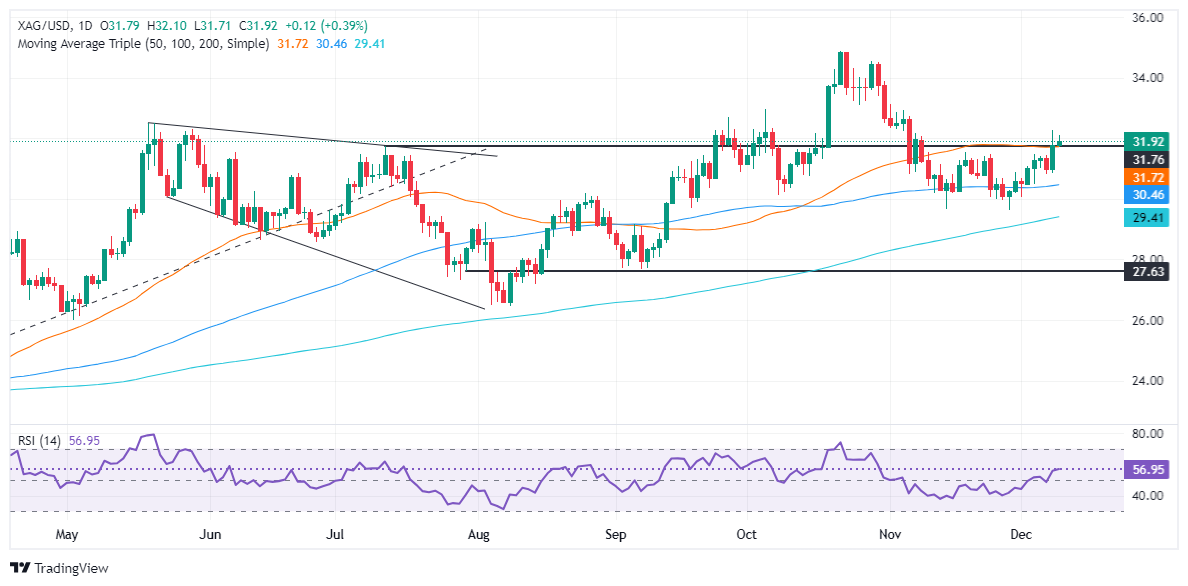Silver Price Forecast: XAG/USD nears $32 hurdle amid Fed rate cut speculation
- Silver gains 0.19%, stabilizing at $31.89 as traders anticipate key U.S. inflation figures and Fed's next steps.
- Technical analysis highlights consolidation near the $32 mark, with $31.75 acting as crucial support.
- Potential downside risks include a fall towards the $31.00 area and the 100-day SMA at $30.47 if bearish pressure mounts.
Silver price climbed some 0.19% on Tuesday yet failed to clear the $32.00 hurdle after hitting a three-week high of $32.27 at the beginning of the week. At the time of writing, XAG/USD trades at $31.89 as Wednesday’s Asian Pacific session commences.
Mounting speculation about a potential Federal Reserve interest rate cut next week is driving market sentiment. The release of US inflation data on Wednesday is expected to provide clearer insights into the Fed’s monetary policy trajectory.
XAG/USD Price Forecast: Technical outlook
After briefly climbing above $32.00, XAG/USD retreated and is now consolidating within the $31.75–$32.00 range, with the 50-day Simple Moving Average (SMA) at $31.75 serving as key support.
The price action suggests the formation of a "double bottom" chart pattern, which remains just short of its minimum target of $33.50. A decisive break above the $32.00 resistance level could strengthen bullish momentum, paving the way toward $33.00 and ultimately the "double bottom" target.
On the other hand, if XAG/USD falls below the 50-day SMA, sellers may gain control, potentially driving prices toward the low $31.00 range. A further decline past this level could bring the 100-day SMA at $30.47 into focus.
XAG/USD Price Chart – Daily
Silver FAQs
Silver is a precious metal highly traded among investors. It has been historically used as a store of value and a medium of exchange. Although less popular than Gold, traders may turn to Silver to diversify their investment portfolio, for its intrinsic value or as a potential hedge during high-inflation periods. Investors can buy physical Silver, in coins or in bars, or trade it through vehicles such as Exchange Traded Funds, which track its price on international markets.
Silver prices can move due to a wide range of factors. Geopolitical instability or fears of a deep recession can make Silver price escalate due to its safe-haven status, although to a lesser extent than Gold's. As a yieldless asset, Silver tends to rise with lower interest rates. Its moves also depend on how the US Dollar (USD) behaves as the asset is priced in dollars (XAG/USD). A strong Dollar tends to keep the price of Silver at bay, whereas a weaker Dollar is likely to propel prices up. Other factors such as investment demand, mining supply – Silver is much more abundant than Gold – and recycling rates can also affect prices.
Silver is widely used in industry, particularly in sectors such as electronics or solar energy, as it has one of the highest electric conductivity of all metals – more than Copper and Gold. A surge in demand can increase prices, while a decline tends to lower them. Dynamics in the US, Chinese and Indian economies can also contribute to price swings: for the US and particularly China, their big industrial sectors use Silver in various processes; in India, consumers’ demand for the precious metal for jewellery also plays a key role in setting prices.
Silver prices tend to follow Gold's moves. When Gold prices rise, Silver typically follows suit, as their status as safe-haven assets is similar. The Gold/Silver ratio, which shows the number of ounces of Silver needed to equal the value of one ounce of Gold, may help to determine the relative valuation between both metals. Some investors may consider a high ratio as an indicator that Silver is undervalued, or Gold is overvalued. On the contrary, a low ratio might suggest that Gold is undervalued relative to Silver.

